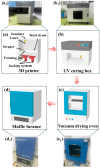Vat Photopolymerization of Sepiolite Fiber and 316L Stainless Steel-Reinforced Alumina with Functionally Graded Structures
- PMID: 38930342
- PMCID: PMC11205472
- DOI: 10.3390/ma17122973
Vat Photopolymerization of Sepiolite Fiber and 316L Stainless Steel-Reinforced Alumina with Functionally Graded Structures
Abstract
Alumina (Al2O3) ceramics are widely used in electronics, machinery, healthcare, and other fields due to their excellent hardness and high temperature stability. However, their high brittleness limits further applications, such as artificial ceramic implants and highly flexible protective gear. To address the limitations of single-phase toughening in Al2O3 ceramics, some researchers have introduced a second phase to enhance these ceramics. However, introducing a single phase still limits the range of performance improvement. Therefore, this study explores the printing of Al2O3 ceramics by adding two different phases. Additionally, a new gradient printing technique is proposed to overcome the limitations of single material homogeneity, such as uniform performance and the presence of large residual stresses. Unlike traditional vat photopolymerization printing technology, this study stands out by generating green bodies with varying second-phase particle ratios across different layers. This study investigated the effects of different contents of sepiolite fiber (SF) and 316L stainless steel (SS) on various aspects of microstructure, phase composition, physical properties, and mechanical properties of gradient-printed Al2O3. The experimental results demonstrate that compared to Al2O3 parts without added SF and 316L SS, the inclusion of these materials can significantly reduce porosity and water absorption, resulting in a denser structure. In addition, the substantial improvements, with an increase of 394.4% in flexural strength and an increase of 316.7% in toughness, of the Al2O3 components enhanced by incorporating SF and 316L SS have been obtained.
Keywords: functionally graded structures; mechanical properties; microstructure characterizations; physical properties; vat photopolymerization.
Conflict of interest statement
The authors declare no conflict of interest.
Figures














References
-
- Zhou Z., Xu Y., Chen X., Han C., Jiang W., Yang B., Xu B., Liu D. Preparation of AlN under Vacuum by the Alumina Carbothermal Reduction Nitridation Method. Ceram. Int. 2020;46:4095–4103. doi: 10.1016/j.ceramint.2019.10.011. - DOI
-
- Nadi M., Esmaeilzadeh A.H., Raftar O.R., Khajehzadeh M., Razfar M.R. An Experimental Study on the Creep Feed Grinding of Laser Macro-Structured Alumina Considering Constant Material Removal Volume. Proc. Inst. Mech. Eng. Part E J. Process Mech. Eng. 2023;238:1385–1397. doi: 10.1177/09544089231156319. - DOI
-
- Luo Y., Zhang W., Ning C., Zhu X., Wang Y., Lu B., Li Y., Zhang X. Alpha-to-Gamma Phase Transformation Self-Reinforcing of Alumina Ceramic Slit Array in Nd:YAG Laser Cutting Based on Vapor-to-Melt Ratio Controlling. Ceram. Int. 2022;48:16977–16989. doi: 10.1016/j.ceramint.2022.02.252. - DOI
-
- Nishio Y., Ozawa M. Preparation and Properties of Porous Lanthanum Doped Alumina Ceramic Composites with Self-Organization. J. Ceram. Soc. Jpn. 2009;117:499–502. doi: 10.2109/jcersj2.117.499. - DOI
Grants and funding
- ZR2023ME154/Shandong Provincial Natural Science Foundation
- No. CXCY2023122/Training Program of Innovation and Entrepreneurship for Undergraduates
- No. S202310447018/Training Program of Innovation and Entrepreneurship for Undergraduates
- No. CXCY2023111/Training Program of Innovation and Entrepreneurship for Undergraduates
LinkOut - more resources
Full Text Sources

